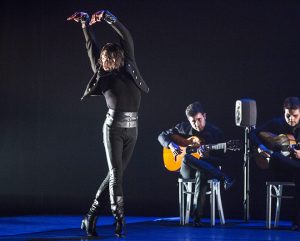Jerez: Summer 2017 - Vancouver Ballet Society
- Home
- City Reports 2015 - 2019
- Jerez: Summer 2017

by Justine Bayod Espoz
Despite a reputation for being one of the most important flamenco festivals in the world, the Jerez Festival found itself facing the possibility that there would be no 21st edition. The first close call came in December 2015, when the Spanish tax agency forced the dissolution of the Villamarta Theatre Foundation — the organization in charge of the municipal theatre and Jerez Festival — under the local reform law that prohibits any municipal company from having more than two years of financial losses. The law was passed by the conservative Partido Popular party in the midst of the economic crisis.
“In 2013 and 2014, we had losses, like almost all theatres in Spain,” explains Isamay Benavente, director of the Villamarta Theatre and Jerez Festival. “The only difference from other theatres was we weren’t able to add money to the foundation at the end of the year to balance the budget. With a longer time frame, we would have, but, in two years, it was impossible. So this law forced us to dissolve the company and prohibited us from starting a new one to continue managing the theatre.” Ultimately, Jerez’s municipal government decided to transfer the functions of the dissolved foundation to the already existing Fundarte (the University Foundation for the Performing Arts and Flamenco of Jerez), but not without first hitting a major roadblock.
Before being officially extinguished on December 31, 2016, Spain’s Ministry of Economy required that the prior foundation’s budget be balanced. In response, the city budgeted additional funding for the theatre in 2016 to cover the debt, but when this amended budget was put up for a city council vote, members of Partido Popular and Ganemos parties kept the budget from being approved, a move that would not only cut the city off from access to opera, ballet and flamenco, but also lay off 27 employees in a city already hard hit by unemployment.
After staff meetings with local politicians, public protests, a Change.org petition and the threat of a strike, a second vote saw the passing of the amended budget thanks to the abstention of Ganemos party members. At two-and-a-half months before the start of the XXI Jerez Festival, it was announced the event would continue at least one more year.
Benavente doesn’t think the instability surrounding the festival has harmed it, but admits it has made growth impossible. There is no doubt the festival has suffered due in large part to the economic crisis, but persistent rumblings amidst press and festival regulars that the Jerez Festival needs to consider a change in its approach to programming seem to ring louder than ever: this edition’s programming fell flat due to the near complete disappearance of other styles of Spanish dance and of up-and-coming artists, which in the past have lent a breath of fresh air to the large-scale format productions that dominate.
The XXI festival’s best and worst performances not only showcased the desire to innovate amongst some flamenco artists and the need to cling to tradition among others, but also, in the two works discussed below, explored gender roles in polarizing manners.
Flamenco virtuoso Eduardo Guerrero surpassed high expectations with what can easily be described as the best production of his career. Guerrero, meaning “warrior” in Spanish, employed General Sun Tzu’s The Art of War and the concept that “the greatest victory is that which requires no battle” to explore a man’s lifelong relationship with women. The three female roles — mother, lover and friend — were poetically portrayed by three singers from Jerez: Anabel Rivera, Sandra Zarzana and Samara Montañez. Music (feminine) and dance (masculine) meld physically and conceptually, inextricably sustaining each other, attracting, repelling, comforting and supporting. The respect and tenderness with which the flamenco art form and the work’s subject matter are handled make this a classic work of choreography and dramaturgy, both of which rest squarely in Guerrero’s more than capable hands.
Far less convincingly was Farruquito’s Baile Moreno, an homage to his father, flamenco singer Juan “El Moreno.” The piece presents generic moments in a man’s life, straining to make Farruquito’s lead appear as manly as possible. There’s a fight scene, a jubilant bar scene, women going out of their way to attract the hero and a wedding featuring the winner of the aforementioned battle for a mate. These clichéd depictions of masculinity and femininity not only boggle the 21st-century mind, but also reinforce antiquated notions about men in flamenco doing little more than macho posturing and bravado. Some may be able to overlook this as quaint gypsy culture, but it might be a little harder to forgive how under-rehearsed the show appeared, with dancers bumping into each other more than once and clumsily transitioning from one moment to the next.

